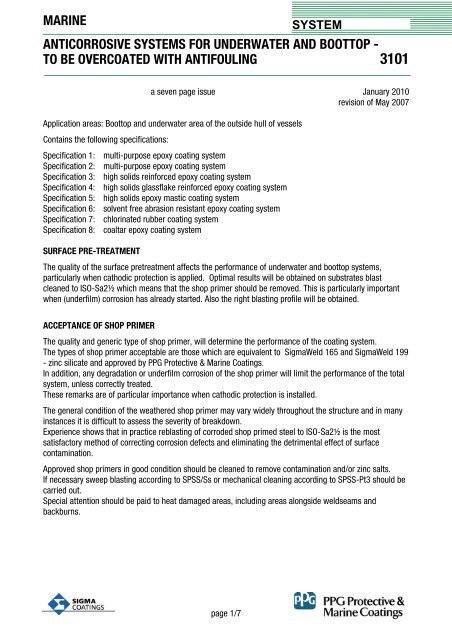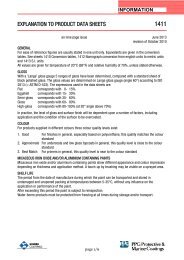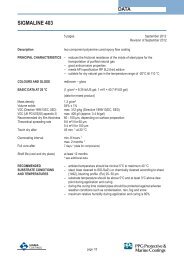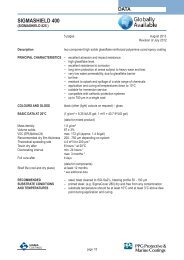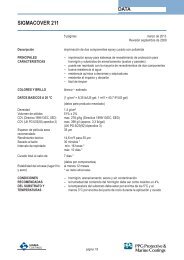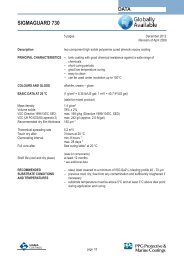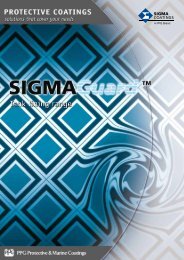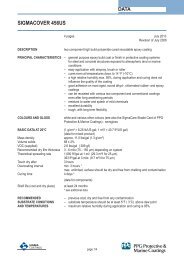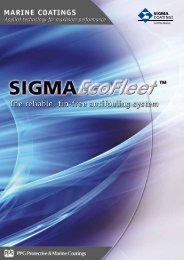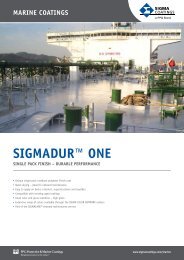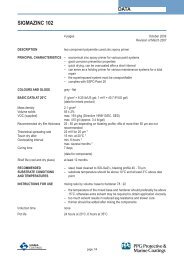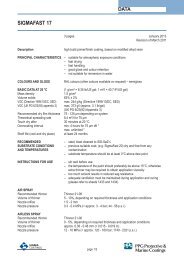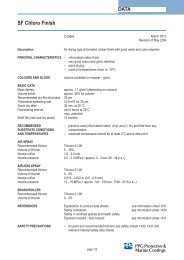system - Sigmacoatings.com - Paint | Coating
system - Sigmacoatings.com - Paint | Coating
system - Sigmacoatings.com - Paint | Coating
Create successful ePaper yourself
Turn your PDF publications into a flip-book with our unique Google optimized e-Paper software.
MARINE<br />
ANTICORROSIVE SYSTEMS FOR UNDERWATER AND BOOTTOP -<br />
TO BE OVERCOATED WITH ANTIFOULING<br />
3101<br />
page 1/7<br />
SYSTEM<br />
a seven page issue January 2010<br />
revision of May 2007<br />
Application areas: Boottop and underwater area of the outside hull of vessels<br />
Contains the following specifications:<br />
Specification 1: multi-purpose epoxy coating <strong>system</strong><br />
Specification 2: multi-purpose epoxy coating <strong>system</strong><br />
Specification 3: high solids reinforced epoxy coating <strong>system</strong><br />
Specification 4: high solids glassflake reinforced epoxy coating <strong>system</strong><br />
Specification 5: high solids epoxy mastic coating <strong>system</strong><br />
Specification 6: solvent free abrasion resistant epoxy coating <strong>system</strong><br />
Specification 7: chlorinated rubber coating <strong>system</strong><br />
Specification 8: coaltar epoxy coating <strong>system</strong><br />
SURFACE PRE-TREATMENT<br />
The quality of the surface pretreatment affects the performance of underwater and boottop <strong>system</strong>s,<br />
particularly when cathodic protection is applied. Optimal results will be obtained on substrates blast<br />
cleaned to ISO-Sa2½ which means that the shop primer should be removed. This is particularly important<br />
when (underfilm) corrosion has already started. Also the right blasting profile will be obtained.<br />
ACCEPTANCE OF SHOP PRIMER<br />
The quality and generic type of shop primer, will determine the performance of the coating <strong>system</strong>.<br />
The types of shop primer acceptable are those which are equivalent to SigmaWeld 165 and SigmaWeld 199<br />
- zinc silicate and approved by PPG Protective & Marine <strong>Coating</strong>s.<br />
In addition, any degradation or underfilm corrosion of the shop primer will limit the performance of the total<br />
<strong>system</strong>, unless correctly treated.<br />
These remarks are of particular importance when cathodic protection is installed.<br />
The general condition of the weathered shop primer may vary widely throughout the structure and in many<br />
instances it is difficult to assess the severity of breakdown.<br />
Experience shows that in practice reblasting of corroded shop primed steel to ISO-Sa2½ is the most<br />
satisfactory method of correcting corrosion defects and eliminating the detrimental effect of surface<br />
contamination.<br />
Approved shop primers in good condition should be cleaned to remove contamination and/or zinc salts.<br />
If necessary sweep blasting according to SPSS/Ss or mechanical cleaning according to SPSS-Pt3 should be<br />
carried out.<br />
Special attention should be paid to heat damaged areas, including areas alongside weldseams and<br />
backburns.
MARINE<br />
page 2/7<br />
SYSTEM<br />
ANTICORROSIVE SYSTEMS FOR UNDERWATER AND BOOTTOP -<br />
TO BE OVERCOATED WITH ANTIFOULINGS<br />
3101<br />
January 2010<br />
SPECIFICATION 1 multi-purpose epoxy <strong>system</strong> for UNDERWATER and BOOTTOP with good<br />
resistance to mechanical impact, abrasion and well designed cathodic<br />
protection<br />
pretreatment steel; blast cleaned to ISO-Sa2½<br />
steel with approved zinc silicate shop primer; sweep blasted to SPSS-Ss,<br />
weld seams, burned and rusty areas; blast cleaned to ISO-Sa2½ or power<br />
tool cleaned to SPSS-Pt3<br />
paint <strong>system</strong> SigmaPrime 700 125 µm<br />
SigmaCover 525 125 µm<br />
antifouling as specified<br />
notes – SigmaCover 525 can be replaced by SigmaCover 555<br />
– at temperatures below 5°C, SigmaPrime 700 can be replaced by<br />
SigmaPrime 700 LT<br />
maintenance should preferably be carried out to this specification<br />
SPECIFICATION 2 multi-purpose epoxy <strong>system</strong> for UNDERWATER and BOOTTOP with good<br />
resistance to mechanical impact, abrasion and well designed cathodic<br />
protection<br />
pretreatment steel; blast cleaned to ISO-Sa2½<br />
steel with approved zinc silicate shop primer; sweep blasted to SPSS-Ss,<br />
weld seams, burned and rusty areas; blast cleaned to ISO-Sa2½ or power<br />
tool cleaned to SPSS-Pt3<br />
paint <strong>system</strong> SigmaPrime 200 125 µm<br />
SigmaCover 525 125 µm<br />
antifouling as specified<br />
notes – SigmaCover 525 can be replaced by SigmaCover 555<br />
– at temperatures below 5°C, SigmaPrime 200 can be replaced by<br />
SigmaPrime 200 LT<br />
maintenance should preferably be carried out to this specification
MARINE<br />
page 3/7<br />
SYSTEM<br />
ANTICORROSIVE SYSTEMS FOR UNDERWATER AND BOOTTOP -<br />
TO BE OVERCOATED WITH ANTIFOULINGS<br />
3101<br />
January 2010<br />
SPECIFICATION 3 high solids reinforced epoxy <strong>system</strong> for UNDERWATER and BOOTTOP with<br />
excellent resistance to mechanical impact, abrasion and well designed<br />
cathodic protection<br />
pretreatment steel: blast cleaned to ISO-Sa2½<br />
steel with approved zinc silicate shop primer: sweep blasted to SPSS-Ss,<br />
weld seams, burned and rusty areas: blast cleaned to ISO-Sa2½ or<br />
power tool cleaned to SPSS-Pt3<br />
paint <strong>system</strong> SigmaShield 220 125 µm<br />
SigmaShield 420 125 µm<br />
SigmaCover 525 75 µm<br />
antifouling as specified<br />
notes – SigmaShield 220 can be replaced by SigmaPrime 200 or 700<br />
– SigmaCover 525 can be replaced by SigmaCover 555<br />
– at temperatures below 5°C, SigmaPrime 200 or 700, SigmaShield 220<br />
and SigmaShield 420 can be replaced by the LT versions<br />
maintenance should preferably be carried out to this specification<br />
SPECIFICATION 4 high solids, glassflake reinforced epoxy <strong>system</strong> on top of in situ applied<br />
epoxy primer for UNDERWATER and BOOTTOP with good resistance to<br />
heavy impact (fender areas - ice going vessels) and well designed<br />
cathodic protection<br />
pretreatment steel; blast cleaned to ISO-Sa2½, blasting profile (Rz) 50 - 100 µm<br />
paint <strong>system</strong> SigmaShield 220 100 µm<br />
SigmaShield 460 400 µm<br />
SigmaCover 525 75 µm<br />
antifouling as specified<br />
notes – if a holding primer is required, SigmaShield 220 can be<br />
replaced by SigmaCover 280 at a dft of 50 µm<br />
– SigmaCover 525 can be replaced by SigmaCover 555<br />
– at temperatures below 5°C, SigmaShield 220 and SigmaShield 460<br />
can be replaced by the LT versions<br />
maintenance should preferably be carried out to this specification
MARINE<br />
page 4/7<br />
SYSTEM<br />
ANTICORROSIVE SYSTEMS FOR UNDERWATER AND BOOTTOP -<br />
TO BE OVERCOATED WITH ANTIFOULINGS<br />
SPECIFICATION 5 high solids, epoxy mastic coating <strong>system</strong> for maintenance of<br />
UNDERWATER and BOOTTOP with good resistance to mechanical<br />
impact and well designed cathodic protection<br />
3101<br />
January 2010<br />
pretreatment steel; blast cleaned to ISO-Sa2½, blasting profile (Rz) 40 - 70 µm<br />
steel with approved zinc silicate shop primer; sweep blasted to SPSS-Ss,<br />
or power tool cleaned to SPSS-Pt3<br />
paint <strong>system</strong> SigmaCover 380 125 µm<br />
SigmaCover 525 125 µm<br />
notes – SigmaCover 380 can be replaced by SigmaCover 630 aluminium<br />
– at temperatures below 5°C, SigmaCover 380 can be replaced by the LT<br />
version<br />
maintenance should preferably be carried according to this specification<br />
pretreatment in case of hydrojetted to VIS WJ2 L or ISO Wa 2½ L SigmaCover 280<br />
should be applied as first coat at a dft of 50 µm (for more info see<br />
information sheet 1498)<br />
SPECIFICATION 6 solvent free, abrasion resistant epoxy <strong>system</strong> for UNDERWATER and<br />
BOOTTOP with excellent resistance to mechanical impact (e.g. for ice<br />
going and ice breaking vessels) and well designed cathodic protection<br />
pretreatment steel; blast cleaned to ISO-Sa2½, blasting profile (Rz) 50 - 100 µm<br />
paint <strong>system</strong> SigmaShield 1200 400 µm<br />
SigmaCover 525 75 µm<br />
antifouling as specified<br />
notes – SigmaCover 525 can be replaced by SigmaCover 555<br />
– at temperatures below 5°C, SigmaShield 1200 can be replaced by<br />
SigmaShield 1200 LT<br />
maintenance should preferably be carried out to this specification
MARINE<br />
page 5/7<br />
SYSTEM<br />
ANTICORROSIVE SYSTEMS FOR UNDERWATER AND BOOTTOP -<br />
TO BE OVERCOATED WITH ANTIFOULINGS<br />
SPECIFICATION 7 chlorinated rubber <strong>system</strong> for UNDERWATER and BOOTTOP with good<br />
resistance to well designed cathodic protection<br />
3101<br />
January 2010<br />
pretreatment steel; blast cleaned to ISO-Sa2½<br />
steel with approved zinc silicate shop primer; sweep blasted to SPSS-Ss,<br />
weld seams, burned and rusty areas; blast cleaned to ISO-Sa2½ or<br />
power tool cleaned to SPSS-Pt3<br />
paint <strong>system</strong> Sigma Vikote 18 light 75 µm<br />
Sigma Vikote 18 dark 75 µm<br />
Sigma Vikote 18 light 75 µm<br />
antifouling as specified<br />
note for touch up areas 2 coats of Sigma Vikote 18 at a dft of 100 µm each can<br />
be specified<br />
maintenance should preferably be carried out to this specification<br />
SPECIFICATION 8 coaltar epoxy <strong>system</strong> for UNDERWATER and BOOTTOP with good<br />
resistance to mechanical impact, abrasion and well designed cathodic<br />
protection<br />
pretreatment steel: blast cleaned to ISO-Sa2½<br />
steel with approved zinc silicate shop primer:<br />
sweep blasted to SPSS-Ss<br />
weld seams, burned and rusty areas: blast cleaned to ISO-Sa2½ or power<br />
tool cleaned to SPSS-Pt3<br />
if a holding primer is required, SigmaCover 280 can be used (dft of 50 µm)<br />
paint <strong>system</strong> SigmaCover 300 brown 125 µm<br />
SigmaCover 510 125 µm<br />
antifouling as specified<br />
note at temperatures below 5°C, SigmaCover 300 can be replaced by<br />
SigmaCover 300 brown LT<br />
maintenance should preferably be carried out to this specification<br />
pretreatment in case of hydrojetted to VIS WJ2 L or ISO Wa 2½ L SigmaCover 280<br />
should be applied as first coat at a dft of 50 µm (for more info see sheet<br />
1498)
MARINE<br />
ANTICORROSIVE SYSTEMS FOR UNDERWATER AND BOOTTOP -<br />
TO BE OVERCOATED WITH ANTIFOULINGS<br />
MAINTENANCE<br />
page 6/7<br />
SYSTEM<br />
3101<br />
January 2010<br />
As in normal dry-docking practice, fouling, loose paint and other contaminants should be removed by high<br />
pressure water cleaning (HPWC). Any fouling and/or loose paint remaining after HPWC must be removed by<br />
scraping or sweep blasting. The removal of an oil or grease belt can be achieved by scraping heavy deposits<br />
from the surface followed by HPWC in <strong>com</strong>bination with the use of suitable detergents. This should be<br />
followed by a thorough fresh water wash and drying prior to blasting and/or repainting. It might, however,<br />
be necessary to blast clean such areas after this operation when oil has penetrated the underlying paint<br />
<strong>system</strong>s. Rusty spots should be pretreated by blast cleaning and touched up with the original anticorrosive<br />
<strong>system</strong> within the requirements given in the relevant specifications.<br />
CATHODIC PROTECTION<br />
Sacrificial zinc anodes produce potential differences related to the Ag/AgCl reference electrode of approx.<br />
minus 1050 mV. As the resistance of bituminous aluminium coatings and chlorinated rubber coatings lie in<br />
the region of this figure it is therefore re<strong>com</strong>mended to apply a protective shield around the anodes when a<br />
vessel with such a coating <strong>system</strong> is fitted with anodes. For this purpose it is re<strong>com</strong>mended to blast the<br />
related area to ISO-Sa2½ followed by 1 coat of 75 µm of SigmaCover 280 and 2 coats of 300 µm each of<br />
SigmaShield 460 as a protective shield.<br />
January 2010
MARINE<br />
ANTICORROSIVE SYSTEMS FOR UNDERWATER AND BOOTTOP -<br />
TO BE OVERCOATED WITH ANTIFOULINGS<br />
REFERENCES<br />
page 7/7<br />
SYSTEM<br />
3101<br />
Sigma Vikote 18 see product data sheet 7318<br />
SigmaCover 280 see product data sheet 7417<br />
SigmaCover 300 see product data sheet 7472<br />
SigmaCover 300 LT see product data sheet 7483<br />
SigmaCover 380 see product data sheet 7979<br />
SigmaCover 380 LT see product data sheet 7980<br />
SigmaCover 510 see product data sheet 7479<br />
SigmaCover 525 see product data sheet 7902<br />
SigmaCover 555 see product data sheet 7905<br />
SigmaCover 630 aluminium see product data sheet 7431<br />
SigmaPrime 200 see product data sheet 7416<br />
SigmaPrime 200 LT see product data sheet 7931<br />
SigmaPrime 700 see product data sheet 7930<br />
SigmaPrime 700 LT see product data sheet 7946<br />
SigmaShield 220 see product data sheet 7922<br />
SigmaShield 220 LT see product data sheet 7926<br />
SigmaShield 420 see product data sheet 7951<br />
SigmaShield 420 LT see product data sheet 7955<br />
SigmaShield 460 see product data sheet 7952<br />
SigmaShield 460 LT see product data sheet 7972<br />
SigmaShield 1200 see product data sheet 7744<br />
SigmaShield 1200 LT see product data sheet 7746<br />
SigmaWeld 165 see product data sheet 7171<br />
SigmaWeld 199 see product data sheet 7177<br />
Cleaning of steel and removal of rust see information sheet 1490<br />
Hydrojetting see information sheet 1498<br />
Prefabrication primers see <strong>system</strong> sheet 3015<br />
Limitation of Liability - The information in this data sheet is based upon laboratory tests we believe to be accurate and is<br />
intended for guidance only. All re<strong>com</strong>mendations or suggestions relating to the use of the Sigma <strong>Coating</strong>s products made by PPG<br />
Protective & Marine <strong>Coating</strong>s, whether in technical documentation, or in response to a specific enquiry, or otherwise, are based<br />
on data which to the best of our knowledge are reliable. The products and information are designed for users having the requisite<br />
knowledge and industrial skills and it is the end-user's responsibility to determine the suitability of the product for its intended<br />
use.<br />
PPG Protective & Marine <strong>Coating</strong>s has no control over either the quality or condition of the substrate, or the many factors<br />
affecting the use and application of the product. PPG Protective & Marine <strong>Coating</strong>s does therefore not accept any liability arising<br />
from loss, injury or damage resulting from such use or the contents of this data sheet (unless there are written agreements<br />
stating otherwise).<br />
The data contained herein are liable to modification as a result of practical experience and continuous product development.<br />
This data sheet replaces and annuls all previous issues and it is therefore the user’s responsibility to ensure that this sheet is<br />
current prior to using the product.


